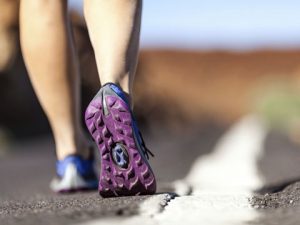What I’ve discussed so far applies to any kind of terrain, but you’ll experience different challenges when you head off road onto trails, grass, or sand. Depending on the softness of the surface or the hilliness of the terrain, you could use from a third more to double the amount of energy you would walking on smooth, paved surfaces. That can be an advantage. But if you’re a beginner, you might tire more quickly, so take your off-road walks in short doses to start.
A few tips for walking on a different terrain start with focusing on your abdominal muscles. Keep them tight to support your back and add power to your stride. Tight abs also help keep you balanced and upright on loose or uneven surfaces. They are the key to just about every movement.
 If you are on a trail with rocks, roots, or an otherwise uneven surface, try to step between obstacles to avoid slipping off them or twisting an ankle. Also, try to stay nimble. Rather than committing to each foot plant by landing solidly with all your weight on a flat foot, stay on your toes slightly so that if you start to slip or twist, you’ll able to make the transition to the next foot quickly without disastrous results.
If you are on a trail with rocks, roots, or an otherwise uneven surface, try to step between obstacles to avoid slipping off them or twisting an ankle. Also, try to stay nimble. Rather than committing to each foot plant by landing solidly with all your weight on a flat foot, stay on your toes slightly so that if you start to slip or twist, you’ll able to make the transition to the next foot quickly without disastrous results.
Hills demand different technique depending on if you’re going up or down. On an uphill, use your toes and lower-leg muscles to push you forward and up. Use your arm swing as a mini-motor for extra power. And don’t lean into the hill; this may strain your back ( see “common walking errors” listed later).
On a downhill, what you do depends on how steep the hill is. On a minor to moderate downhill, soften or relax your knees just a bit to counteract the additional impact as gravity tries to pull each foot quickly to the ground. Rather than leaning back, remain upright. On a steeper downhill, you might be more comfortable zigzagging like a skier to lessen the steepness. You might also want to lean back just a little if the surface is smooth and paved. If the surface of the hill is uneven or loose, don’t sit back on your heels. This may throw your weight back, causing your feet to slip out from under you, leaving you on your behind.

Leave a Reply